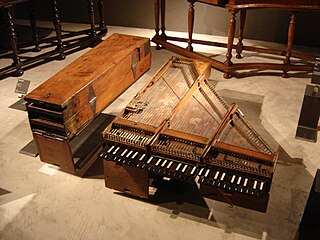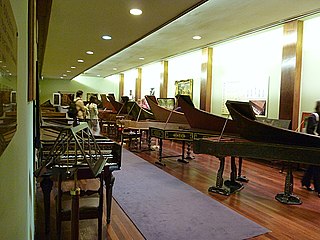
A harpsichord is a musical instrument played by means of a keyboard. This activates a row of levers that turn a trigger mechanism that plucks one or more strings with a small plectrum made from quill or plastic. The strings are under tension on a soundboard, which is mounted in a wooden case; the soundboard amplifies the vibrations from the strings so that the listeners can hear it. Like a pipe organ, a harpsichord may have more than one keyboard manual, and even a pedal board. Harpsichords may also have stop buttons which add or remove additional octaves. Some harpsichords may have a buff stop, which brings a strip of buff leather or other material in contact with the strings, muting their sound to simulate the sound of a plucked lute.

A keyboard instrument is a musical instrument played using a keyboard, a row of levers that are pressed by the fingers. The most common of these are the piano, organ, and various electronic keyboards, including synthesizers and digital pianos. Other keyboard instruments include celestas, which are struck idiophones operated by a keyboard, and carillons, which are usually housed in bell towers or belfries of churches or municipal buildings.

Bartolomeo Cristofori di Francesco was an Italian maker of musical instruments famous for inventing the piano.

A spinet is a smaller type of harpsichord or other keyboard instrument, such as a piano or organ.

The virginals is a keyboard instrument of the harpsichord family. It was popular in Europe during the late Renaissance and early Baroque periods.

A clavicytherium is a harpsichord in which the soundboard and strings are mounted vertically facing the player. The primary purpose of making a harpsichord vertical is the same as in the later upright piano, namely to save floor space. In a clavicytherium, the jacks move horizontally without the assistance of gravity, so that clavicytherium actions are more complex than those of other harpsichords.
The oval spinet is a type of harpsichord invented in the late 17th century by Bartolomeo Cristofori, the Italian instrument maker who later achieved fame for inventing the piano. The oval spinet was unusual for its shape, the arrangement of its strings, and for its mechanism for changing registration.
Hieronymus Albrecht Hass was a German harpsichord and clavichord maker. He was the father of Johann Adolph Hass, who also made harpsichords and clavichords.

Johann Adolph Rudolph Hass, usually known as Johann Adolph Hass, was a German maker of clavichords, harpsichords and possibly organs. He was the son of Hieronymus Albrecht Hass, also a maker of keyboard instruments.

The harpsichord was an important keyboard instrument in Europe from the 15th through the 18th centuries, and as revived in the 20th, is widely played today.
Stewart Pollens is an expert on historical musical instruments. His work includes restoration, analysis, and scholarly publication; and it embraces keyboard instruments as well as historical stringed instruments such as the violin and cello. Andrew Manze has called him "one of the world’s foremost authorities on musical instruments."

The spinettone was a kind of harpsichord invented in the late 17th century by Bartolomeo Cristofori, who was later the inventor of the piano. Other names for this instrument were spinettone da teatro, spinetta traversa.

The folding harpsichord was a kind of harpsichord meant for travel. Since it could be folded up into a fairly compact space, it was more easily transported than a conventional harpsichord. The folding took place on hinges and was in the longitudinal dimension, preserving the tension on the strings. The folded instrument formed a package about the size of a large suitcase.
Leopoldo Franciolini (1844–1920) was an Italian antique dealer who was active in the late 19th and early 20th centuries. He is remembered as a fraudster who sold faked and altered historical musical instruments. To this day his work is a barrier to the scholarly study of instruments of the past.

The Denis family were French harpsichord makers from the mid 16th century to the beginning of the 18th century, by which time the Blanchet family had superseded them as the main harpsichord building dynasty in Paris. Members of the Denis family headed the instrument makers' guild for several generations, but only four harpsichords by members of the family have survived to modern times, and three spinets. Several of the Denis instruments are signed in red chalk under the sound board with the makers name, place of construction and date, along with three five-pointed stars. Instruments by the Denis family were held in high regard well after their time, as witnessed by an entry in the Encyclopédie Methodique from 1785: "The best makers of ordinary harpsichords have been the Ruckers in Antwerp... and Jean Denis of Paris".

Albert Delin was a harpsichord maker in the Austrian Netherlands.

The Donzelagues were a family of harpsichord makers in southern France in the 17th and 18th centuries.
The Antunes family were Portuguese harpsichord- and early piano builders in the 18th and 19th centuries.

The Russell Collection is a substantial collection of early keyboard instruments assembled by the British harpsichordist and organologist Raymond Russell. It forms part of the Musical Instrument Museums collection of the University of Edinburgh, and is housed in St Cecilia's Hall. Its full name is the Raymond Russell Collection of Early Keyboard Instruments.















